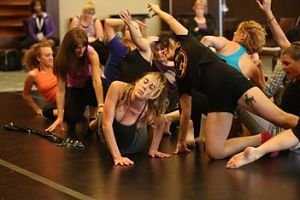In our previous blog article we looked at some basic concepts towards building a choreography-composition curriculum that supplies students with a strong foundation regarding initial design components. Once they have mastered the concepts including: motivations & clarity, musical component, space travel & pathways, weight, energy force & effort qualities, etc., it’s time to develop them into form and structure through phrase development and full length works.
Below are some key ways in which we can guide our young choreographers into doing just that. Keep in mind that it’s simpler to start off choreographing solos then duos, trios, small groups, etc. so that students are concentrated on a small number of dancers in the space while isolating and exploring each concept one at a time.
MOTIF & PHRASE DEVELOPMENT: One way a choreographer can prompt scores is by starting with a motif; a single movement or very short movement phrase developed into a longer sequence. Commonly presented as what often-times embodies a single gesture, a motif can then be developed and manipulated through various avenues including basic choreographic devices, as described below. Although a motif is minimal and brief, the one or two simple movements can create the feel and mood of what the piece will ultimately convey and the structure it will take. Dancers should spend ample time either coming up with a motif to spark the motivation for their piece or use an existing motivational concept to prompt the motif, or initial movement the choreography will grow from.
BASIC FORM: When looking at basic form, keep it simple for beginner students and have them first isolate the following concepts and then add variables of such and include ideas like:
Incorporate a clear beginning-middle-end
Climax
Unison
Variety
Contrast
Sequencing
Transitions There is so much choreographers can play around with involving basic form, so encourage them to try different approaches to visually see what works best for their conceptual intent. Choreographers should never just settle on the first idea and should remember the studio is their lab to experiment and play while exhausting possibilities.
BASIC CHOREOGRAPHIC STRUCTURES: Along with form comes the structure of the piece. Once a choreographer has gotten to the point of linking phrases and developing them into a full length work they also need to think about the structure in which those phrases will have. Work with short phrases of movement and explore each of the following structures one-by-one first to ensure complete understanding:
AB Form: (i.e. a theme & a contrasting theme)
ABA Form (i.e. a theme, a contrasting theme, return to original theme)Rondo:
ABACADA (basic theme A’ keeps returning)
Theme & Variation (internal sequence remains constant)
Narrative
Collage
BASIC CHOREOGRAPHIC DEVICES & PHRASE MANIPULATION: Choreographic devices are perhaps the most powerful tools a choreographer can use to create the dimension, dynamics, texture, levels and look of their works. Since the possibilities are infinite in terms of how movement can be manipulated, have students play with each of the following using their motif or a count of eight first before tackling a full-length work:
Repetition
Retrograde
Inversion
Size: Condense/Expand
Tempo
Rhythm
Effort Qualities
Body Part Initiation (“Instrumentation”)
Force
Canon
Additive
Fragmentation
Changing Planes/Levels
FEEDBACK, CRITIQUE & EDIT: Once your composition students have reached the half-way mark, think about having previews where peers can see each other’s works-in-progress and provide suggestive feedback for the choreographer during the editing process. This can be a tricky part of composition class when students are essentially giving critical feedback to others. Remind the class at the beginning of the session that you are all there to help motivate and provide another set of eyes; offering the choreographer other vantage points and suggestions; where they may or may not choose to ultimately take their final works. The environment should always stay positive and supportive and students should also be sure to articulate aspects they enjoyed and appreciated as well!
Good luck!
See you all in the dance studio,
Jessie

